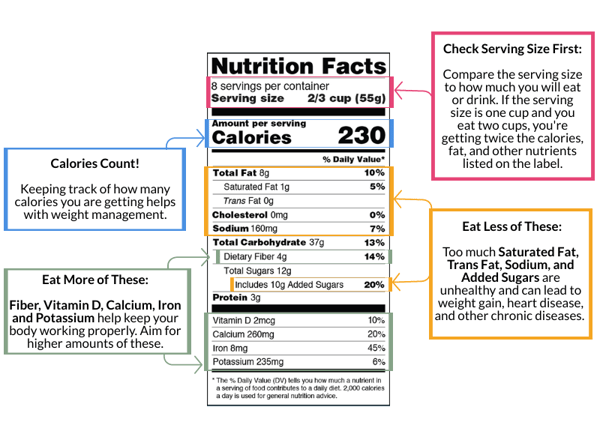5 Common Food Label Misconceptions

What are those percentages on a nutrition label? Is 800mg of sodium a lot? What exactly is the difference between carbs and sugars? We’ve all been there: standing in a grocery store aisle, turning over that jar, pretending to be a pro at analyzing all those numbers and terms on a nutrition label, when in reality, our minds have a million questions.
Even as a dietitian, I recognize that nutrition labels can easily become confusing. Here are the top misconceptions I’ve seen with reading food labels and how you can use this knowledge to empower your own choices.
1. Serving Size: one package of a food item doesn’t mean one serving.
For example, the 200 calories listed on a box of dried pasta doesn’t mean that the whole box is 200 calories. It refers to the calories in one serving, so if there are 8 servings in a box, then eating the whole box of pasta would equal 1,600 calories. That pattern governs the rest of the label as well! Also, one serving size is just the typical amount consumed, so don’t feel bad about slightly adjusting that if that’s what fits in your lifestyle.
Bottom line: Keep an eye on serving size as a guide to not overdose on one food! Add lots of veggies to dishes if you feel unsatisfied (they’ll add water, fiber, and nutrients without a lot of calories or fat) like how we pair vegetables with proteins in our Grilling Boot Camp for example.
 Image source: https://www.snap4ct.org/understanding-the-nutrition-label.html
Image source: https://www.snap4ct.org/understanding-the-nutrition-label.html
2. % Daily Values: these percentages don’t add up to equal 100% of that item.
Many think that the percentages listed on the label are the percentage of that food that is protein, carbohydrate, etc. which would essentially all add up to 100%. However, the daily values actually refer to the overall amount of each nutrient that’s recommended to eat in a whole day and how much is found in one serving of that item.
For instance, 25% of the daily value of calcium means that by eating one serving of that item, you’re getting 25% or one fourth of the total amount of calcium you’re recommended to eat in one day.
Bottom line: use these as a guide to see if you’re getting a lot (20% or more is “high”) or too little (5% or less is “low”) of a nutrient in your day’s meals.
3. 2,000 Calorie a Day: Everyone should not be eating 2,000 calories a day.
This is a big one. The 2,000 calories a day are used as a baseline for general nutrition advice (since they have to start somewhere) and are not intended to be a recommendation for everyone. Our bodies and nutritional needs are incredibly complex and individualized; one person might feel satisfied with 1,800 calories of food one day, but 2,200 calories the next, while a different person might need 2,300 calories a day on average.
Bottom line: do not restrict or push yourself to follow the 2,000 calorie number. Listen to your body and find a lifestyle (not a number) that works for you.
4. Total Carbohydrates and Total Sugars: Are they the same? Different?
Don’t worry, these are quite tricky to understand. Carbohydrates are one of three macronutrients (the other two being protein and fat) that include fibers, starches, and sugars and are broken down into glucose or blood sugar as our body’s preferred energy source. So, sugar is just one slice out of the total pie that makes up the carbohydrate category.
Bottom line: While carbs in general are not the enemy (think of the whole grains, fruits, and vegetables that have carbs, but are extremely beneficial for us), “added sugar” (the sugar added in desserts, soda, fruit juice, etc.) is the subcategory that you should limit to less than 10% of your daily calorie intake (as little as possible).
 5. Ingredients: This list isn’t just a list!
5. Ingredients: This list isn’t just a list!
Ingredients are actually listed in order of quantity, with the ingredients used in the greatest amounts listed first. However, it’s important to note that sodium, added sugar, and saturated and trans fats (nutrients to limit) use many different names and even if they’re not listed as the number one ingredient, they can still be consumed in excess since many packaged foods add extra of these nutrients. This is why cooking or preparing foods at home is a huge pro for your health since even if you add salt or sugar, you’re more than likely adding less total salt than what would’ve been found in a package (fun fact: more than 75% of your dietary sodium comes from packaged and restaurant food, not from your home).
Bottom line: look for ingredients you can read/recognize and cook from home when you can!
In addition to educating yourself, cooking from home is an effective way to contribute to your health (and maybe avoid the headache from reading nutrition labels) and The Chopping Block has plenty of classes to help you with tasty recipes, tips and tricks to make that easier.

